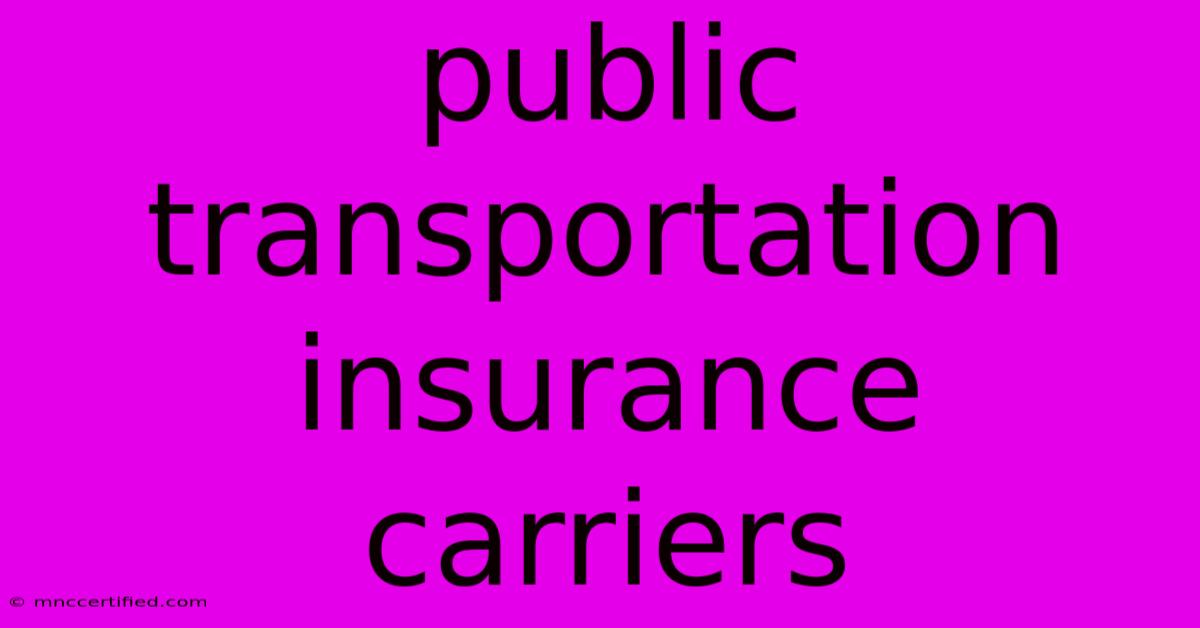Public Transportation Insurance Carriers

Table of Contents
Navigating the Tracks: A Guide to Public Transportation Insurance Carriers
Public transportation is a vital part of modern life, offering a safe and efficient way to travel. But what happens when accidents occur? Understanding the role of public transportation insurance carriers is crucial for both passengers and operators. This guide will demystify the world of public transportation insurance, exploring the different types of coverage, key considerations, and the importance of choosing the right carrier.
Who Needs Public Transportation Insurance?
While the specific requirements may vary depending on jurisdiction, most public transportation operators need insurance coverage, including:
- Transit Agencies: Cities, counties, and regional authorities responsible for bus, rail, and ferry services.
- Private Operators: Companies providing bus, taxi, shuttle, or ride-sharing services.
- Public-Private Partnerships: Collaborations between government entities and private companies for transportation infrastructure and operation.
Types of Public Transportation Insurance Coverage
Public transportation insurance policies are designed to address the unique risks associated with this industry. Key coverages include:
1. Liability Insurance: This coverage protects operators from financial losses due to accidents, injuries, or property damage caused by their vehicles or operations. This includes:
- Bodily Injury: Covers medical expenses, lost wages, and pain and suffering for passengers and pedestrians injured in accidents.
- Property Damage: Covers damage to other vehicles, infrastructure, or property involved in an accident.
2. Passenger Liability Insurance: This coverage specifically addresses the unique risks of transporting passengers. It can cover:
- Personal Injury: Protection against claims for physical or emotional harm, including claims related to assault or harassment.
- Baggage Loss or Damage: Compensation for lost, damaged, or stolen belongings during transit.
- Passenger Accident Insurance: Provides coverage for passengers in case of accidents, including medical expenses, death benefits, and disability payments.
3. Property Insurance: This covers damage to the operator's vehicles, infrastructure, and other assets. This can include:
- Collision Coverage: Protects against damage to vehicles in accidents.
- Comprehensive Coverage: Covers damage from non-accident events, such as fire, theft, vandalism, or natural disasters.
- Liability for Property Damage: Provides protection against claims for damage to third-party property.
4. Workers' Compensation Insurance: This coverage is mandatory in many jurisdictions and protects employees from injuries or illnesses sustained while on the job. It covers medical expenses, lost wages, and disability benefits.
Key Considerations for Public Transportation Insurance
Choosing the right insurance carrier is crucial for minimizing risk and ensuring adequate financial protection. Key factors to consider include:
- Coverage Limits: Determine the maximum amount of financial protection available for different types of claims.
- Deductibles: The out-of-pocket amount the operator must pay before the insurance policy kicks in.
- Premium Costs: The price of the insurance policy, which can vary based on factors like fleet size, vehicle type, operational area, and claims history.
- Claims Service: Investigate the carrier's reputation for handling claims promptly and fairly.
Finding the Right Public Transportation Insurance Carrier
1. Research and Compare: Explore multiple carriers specializing in public transportation insurance. Use online resources, industry associations, and contact insurance brokers for quotes and information.
2. Seek Expert Advice: Consult with an insurance broker experienced in the public transportation industry. They can provide tailored advice based on your specific needs and risk profile.
3. Consider Your Specific Needs: Evaluate your coverage requirements based on the type of transportation services you provide, the size of your fleet, your operating area, and your risk tolerance.
4. Negotiate Carefully: Don't be afraid to negotiate terms and conditions with potential carriers to ensure the best possible coverage and price.
5. Review Regularly: Periodically review your insurance policy to ensure it continues to meet your changing needs and risk profile.
Importance of Choosing the Right Carrier
Choosing the right public transportation insurance carrier is vital for protecting your business, your passengers, and your employees. A comprehensive policy with adequate coverage limits, reasonable deductibles, and reliable claims service can provide essential financial security and peace of mind.
By understanding the complexities of public transportation insurance and carefully selecting a carrier, operators can ensure they have the right protection in place to navigate the often-unpredictable world of public transportation.

Thank you for visiting our website wich cover about Public Transportation Insurance Carriers. We hope the information provided has been useful to you. Feel free to contact us if you have any questions or need further assistance. See you next time and dont miss to bookmark.
Featured Posts
-
Mark Robins Sacked Coventry Citys Decision
Nov 08, 2024
-
How To Get Purewick Covered By Insurance
Nov 08, 2024
-
Manchester United Vs Paok Europa League Live Stream
Nov 08, 2024
-
Fc Barcelona Codorniu Sign New Agreement
Nov 08, 2024
-
Tottenhams 10 Man Loss Osimhens Key Role
Nov 08, 2024